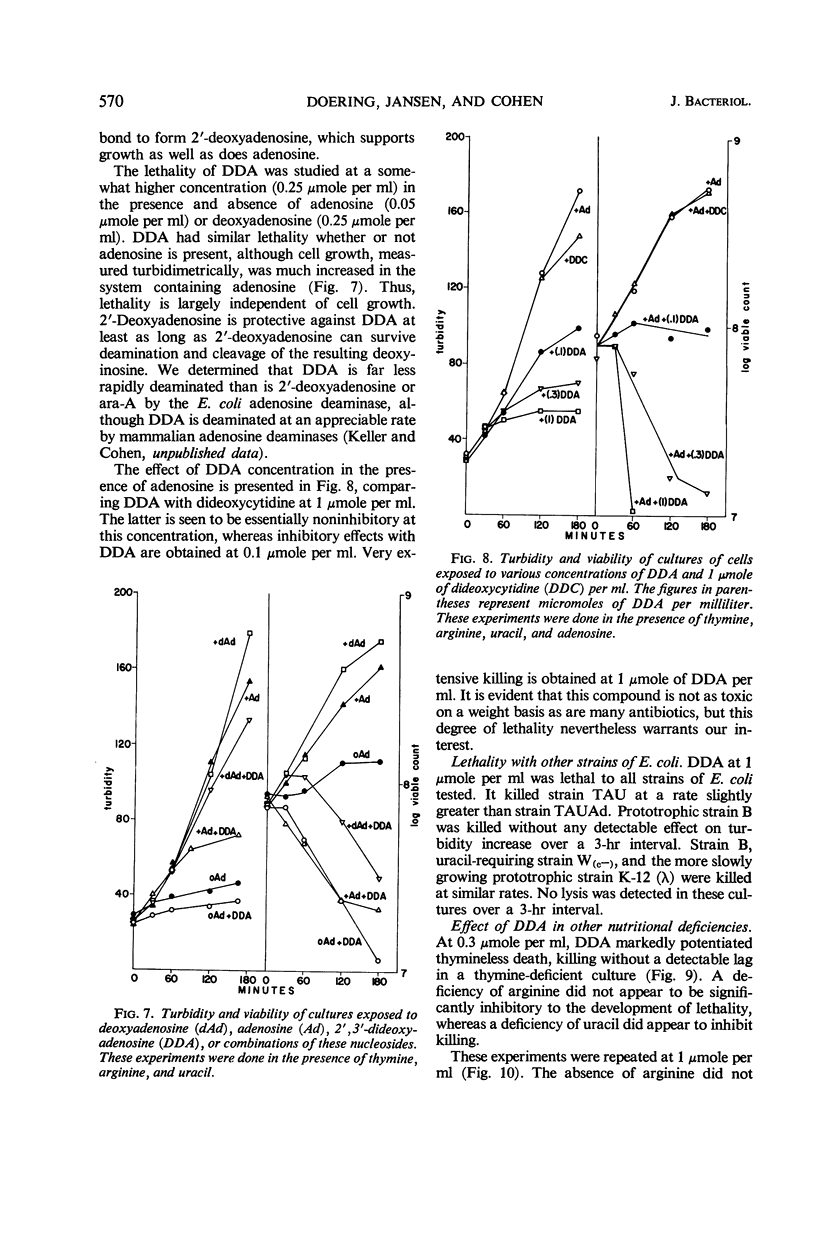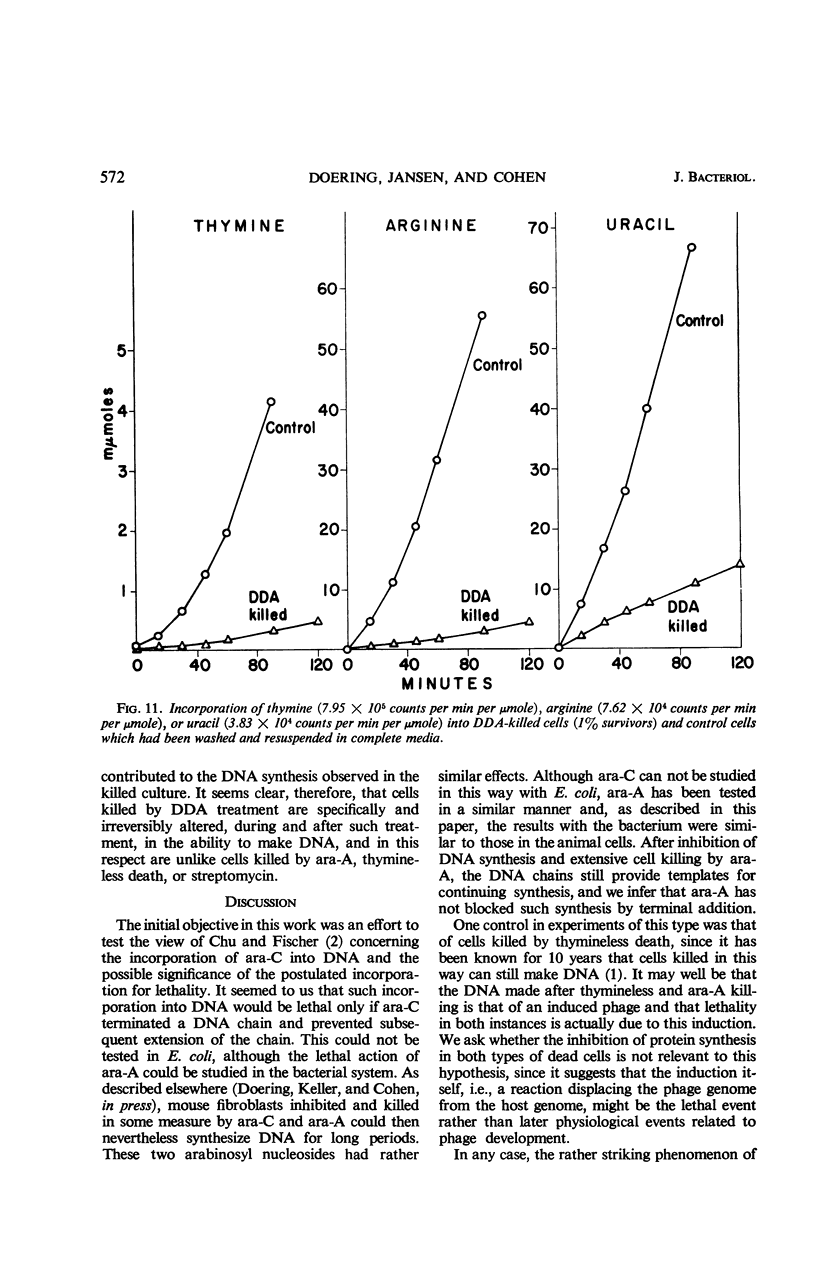Abstract
Doering, Alice McGovern (University of Pennsylvania School of Medicine, Philadelphia), Miekie Jansen, and Seymour S. Cohen. Polymer synthesis in killed bacteria: lethality of 2′,3′-dideoxyadenosine. J. Bacteriol. 92:565–574. 1966.—We studied the metabolic capabilities of cells that had lost the ability to multiply under a variety of lethal treatments. Cultures of a polyauxotrophic mutant of Escherichia coli strain 15 requiring thymine, arginine, uracil, and adenine for growth were killed to a few per cent survivors by several different methods. These treatments included streptomycin, thymineless death, d-arabinosyladenine (ara-A), and 2′,3′-dideoxyadenosine (DDA). The killed cells were washed and supplied with complete media, and were compared with control cells with respect to the ability to incorporate thymine, arginine, and uracil. Cells killed with streptomycin in the absence of thymine were only partially inhibited in deoxyribonucleic acid (DNA) synthesis; they were markedly inhibited in synthesis of ribonucleic acid (RNA) and protein. Cells that had suffered thymineless death were essentially uninhibited in DNA synthesis, partially so in RNA synthesis, but extensively inhibited in protein synthesis. Killing by ara-A did not prevent DNA synthesis, but markedly inhibited RNA and protein synthesis. The lethality of DDA was studied in the presence of exogenous adenosine; lethality was partially prevented by deoxyadenosine. Dideoxyadenosine was similar to ara-A and thymineless death in killing in a pattern in which RNA and protein synthesis continued while DNA synthesis was inhibited. Cells killed by DDA, however, were markedly inhibited in subsequent thymine incorporation, unlike cells killed by the other methods. In addition, at this time, the DDA-killed cells were more inhibited in incorporation of arginine than of uracil. DDA also potentiated thymineless death; when cells were killed rapidly by the combined treatment, only the ability to synthesize DNA was lost irreversibly. This agent (DDA) may permit the detailed study in E. coli of the relation of DNA synthesis to numerous phenomena, such as genetic recombination, sequential transcription, and the number and distribution of chromosome breaks.
Full text
PDF









Selected References
These references are in PubMed. This may not be the complete list of references from this article.
- BARNER H. D., COHEN S. S. Synchronization of division of a thymineless mutant of Escherichia coli. J Bacteriol. 1956 Jul;72(1):115–123. doi: 10.1128/jb.72.1.115-123.1956. [DOI] [PMC free article] [PubMed] [Google Scholar]
- Horwitz J. R., Chua J., Da Rooge M. A., Noel M., Klundt I. L. Nucleosides. IX. The formation of 2',2'-unsaturated pyrimidine nucleosides via a novel beta-elimination reaction. J Org Chem. 1966 Jan;31(1):205–211. doi: 10.1021/jo01339a045. [DOI] [PubMed] [Google Scholar]
- Leung H. B., Doering A. M., Cohen S. S. Effect of 9-beta-D-arabinofuranosyladenine on polymer synthesis in a polyauxotrophic strain of Escherichia coli. J Bacteriol. 1966 Sep;92(3):558–564. doi: 10.1128/jb.92.3.558-564.1966. [DOI] [PMC free article] [PubMed] [Google Scholar]
- MAALOE O., HANAWALT P. C. Thymine deficiency and the normal DNA replication cycle. I. J Mol Biol. 1961 Apr;3:144–155. doi: 10.1016/s0022-2836(61)80041-7. [DOI] [PubMed] [Google Scholar]
- Robins M. J., McCarthy J. R., Jr, Robins R. K. Purine nucleosides. XII. The preparation of 2',3'-dideoxyadenosine, 2',5'-dideoxyadenosine, and 2',3',5'-trideoxyadenosine from 2'-deoxyadenosine. Biochemistry. 1966 Jan;5(1):224–231. doi: 10.1021/bi00865a029. [DOI] [PubMed] [Google Scholar]
- STERN J. L., COHEN S. S. LETHALITY AND THE STIMULATION OF RNA SYNTHESIS BY STREPTOMYCIN. Proc Natl Acad Sci U S A. 1964 May;51:859–865. doi: 10.1073/pnas.51.5.859. [DOI] [PMC free article] [PubMed] [Google Scholar]


